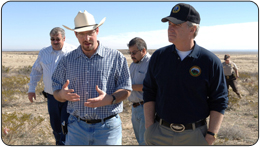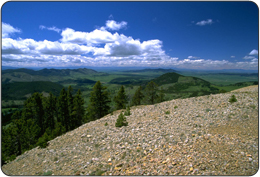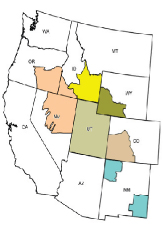 To
maintain healthy landscapes, sustain wildlife and secure energy for the nation,
this initiative supports a holistic, landscape-level approach to natural
resource management and restoration in key areas across eight Western states.
The FY 2009 budget proposes $21.9 million for this initiative, a $14 million
or 177 percent, increase over the enacted 2008 funding level. The Bureau
of Land Management would receive a $10 million increase to expand its efforts.
The targeted areas have experienced numerous pressures – such as population
growth, energy development, wildfire, and the spread of weeds – that
affect land health. To
maintain healthy landscapes, sustain wildlife and secure energy for the nation,
this initiative supports a holistic, landscape-level approach to natural
resource management and restoration in key areas across eight Western states.
The FY 2009 budget proposes $21.9 million for this initiative, a $14 million
or 177 percent, increase over the enacted 2008 funding level. The Bureau
of Land Management would receive a $10 million increase to expand its efforts.
The targeted areas have experienced numerous pressures – such as population
growth, energy development, wildfire, and the spread of weeds – that
affect land health.
The U.S. Geological Survey, a partner in this multi-bureau initiative, would
receive a $3.5 million increase to continue work in Southwest Wyoming, conducting
an ecological assessment to develop a baseline of scientific information
related to wildlife habitat and development activities occurring or planned.
Tools, models and protocols developed will be transferred and applied to
other areas.
The U.S. Fish and Wildlife Service will receive a $492,000 increase,
bringing
the total funding request to $2 million to support restoration of 970 acres
of upland and 6 miles of riparian habitats in the Green River Basin, Wyoming.
This increase, provided to the Partners for Fish and Wildlife Program, will
assist private landowners to restore habitat on their lands.
These Projects that include landscape-scale efforts such as restoration of habitat, weed management, and improvement of riparian areas, are located in New Mexico, Wyoming, Utah, Oregon/Idaho/Nevada, southern Idaho and Colorado Projects.
The Department of Interior's Healthy Lands Initiative recognizes the need to enhance the availability of affordable oil, gas and other energy sources, while maintaining strong environmental protections and protecting habitat. more
 The Department of Interior's Healthy Lands Initiative recognizes the need to enhance the availability of affordable oil, gas and other energy sources, while maintaining strong environmental protections and protecting habitat. The Department of Interior's Healthy Lands Initiative recognizes the need to enhance the availability of affordable oil, gas and other energy sources, while maintaining strong environmental protections and protecting habitat.
The Healthy Lands Initiative in President Bush's FY 2008 budget expanded cooperative conservation efforts to help restore nearly half a million acres of western land that hosts world-class wildlife habitat and energy resources and provides major economic benefits to local communities.
The $22 million investment combined the wildlife science and land-managing expertise of Interior agencies with the knowledge and experience of local communities, companies and conservation groups to rehabilitate and protect working landscapes, while continuing to provide access to their vital energy resources for the nation.
“"Interior manages millions of acres of public lands as working landscapes for communities, supporting grazing, energy and minerals production, hunting and fishing and other recreational activities," Interior Secretary Dirk Kempthorne said. "As we seek enhanced energy security through domestic oil and natural gas production, we must maintain healthy lands for wildlife and their habitat."
"We must actively manage species, such as the sage grouse, to prevent its listing under the Endangered Species Act and to assure the recovery of other threatened and endangered species," Kempthorne said. "The Healthy Lands Initiative will allow us to accomplish that by providing new resources, innovative landscape-scale approaches to restoration and coordinated efforts among public and private partners."
The initiative, the first of its kind, focuses on six projects in areas facing the greatest challenges in managing natural resources to maintain multiple use. Five of these areas contain the largest onshore reserves of natural gas in the country.
Each project received a portion of the funding: southwest Wyoming ($4.5 million); northwest and southeast portions of New Mexico ($3.5 million); Utah ($2 million); the three-corner state area between Idaho, Oregon, and Nevada ($1.9 million); south-central Idaho ($1.8 million); and southwestern Colorado ($1.3 million). The initiative leveraged an additional $10 million in-kind and monetary contributions from state, local and tribal governments, philanthropic organizations, conservation groups and energy industry partners.
Wyoming's Green River Basin, for example, is a priority site because its landscape and habitats are undergoing rapid change in response to recent energy-resource development to meet America's growing need for energy. The area's sagebrush habitat supports significant numbers of plants and animals that depend on this ecosystem. Wyoming is home to more than 800 species of wildlife, 12 of which are federally listed as threatened or endangered. The Green River Basin alone has 9 listed species. Federally managed lands in southwest Wyoming also contain an estimated 1.9 billion barrels of oil and more than 57 trillion cubic feet of natural gas.
The initiative's landscape-scale restoration strategy uses proven tools, including hand thinning and mechanical and chemical removal of non-native species to reduce their competition with native shrubs, grasses, and flowering plants. Prescribed fire and green stripping also reduces the threat of catastrophic wildfire. Aerial seeding re-establishes native plants. The initiative will restore about 35,000 acres in Wyoming and 65,000 acres in New Mexico.
 | Healthy Land Initiatives
Project Areas |
Restored landscapes increase water quality and quantity; reduce erosion and silt deposits in streams and reservoirs; return healthy rangeland conditions with a mix of desired species; protect at-risk natural sites; and improve habitat for wildlife, such as sage grouse, muledeer, antelope, quail and numerous other species. By reducing the build-up of invasive species, such as cheatgrass and shrub areas, restoration also lessens the treat of catastrophic wildfires.
Healthy Land Initiatives
Project Areas
The use of new technology also helps to reduce habitat impacts and protect landscapes. Directional drilling, which allows access to multiple wells from a single drilling pad, reduces the environmental footprint of energy production, preserving critical habitat.
Under the initiative, the U.S. Geological Survey received $5 million to build the geospatial framework for sharing information; assess the health of habitats and their resources; and monitor changes in landscapes to ensure the long-term viability and sustainability of wildlife, terrestrial, and aquatic resources in energy development areas. The Fish and Wildlife Service will use $2 million to work with private landowners to conserve species at risk, exploring the use of tools such as mitigation and conservation banks.
The Bureau of Land Management received $15 million to carry out landscape restoration and enhancement activities in all habitat types, with a special focus on sagebrush, mountain shrub, aspen, and riparian communities. The projects will work in close partnership with federal leaseholders, private landowners, state, local, and tribal governments.
|